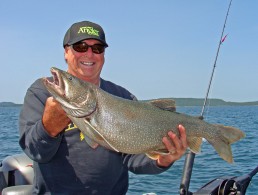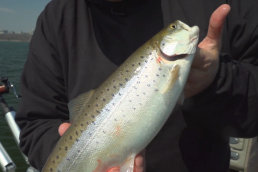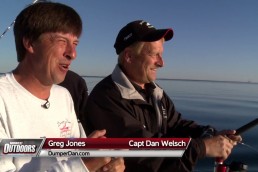Northern Lake Superior: Lake Trout Heaven
SHARE THIS POST
It was a glorious day on the Great Lakes. The sun was shining, the wind was calm and we had not seen another boat all morning. In fact, the area where we were fishing was so isolated that we only saw one other fishing boat all week. The fish were biting, too. What could be better?
Three friends and I were fishing the remote northern shores of Lake Superior in Ontario, Canada. It was late July, and the lake trout bite was absolutely on fire. We were fishing with Capt. Darrell Splett from North Superior Charters (northsuperiorcharters.ca), and he was zeroing in on one of his favorite underwater reefs where he knew lots of hungry lake trout would be waiting for us.
Darrell was watching the electronics and said we were approaching the next underwater reef. The tree-lined shore was not very far away, so I wondered how deep it could be in this spot. I was surprised when I looked at the graph and saw that we were trolling in nearly 150 feet of water! Suddenly, the graph lit up with what looked like an underwater mountain. Jagged peaks quickly came into view on the screen and leveled out as our boat kept moving forward. It was the reef that Darrell had just mentioned.
The rocky reef rose to within 60 feet of the surface, and we could see the unmistakable arc-like images of fish positioned on top of the reef and around the sides. Even though four of us were fishing, we were only trolling with two rods—and they were more than enough. The lures were set with downriggers at 53 feet and 55 feet, and almost as soon as our trolling spoons fluttered over the top of the reef, both rods sprang to life.
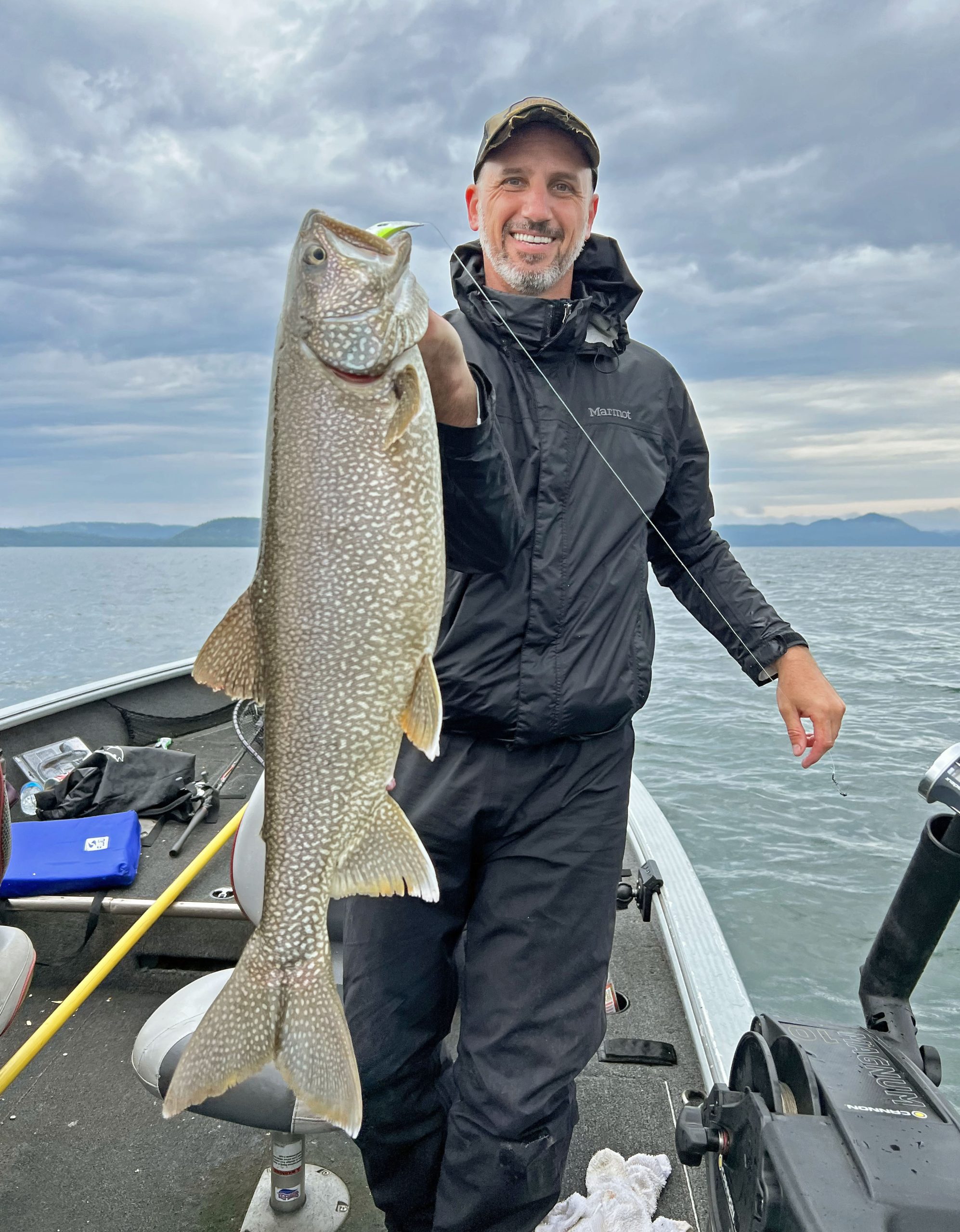
“Fish on! Fish on!” Both rods had been slammed at the same time by two different unseen fish below! Doug Wheelock and his son Barry jumped up, each grabbed a rod and the battle was on. Darrell slowed the boat a bit and moved the downriggers out of the way. My friend Mike Schoonveld grabbed the landing net and got into position to net the first fish that showed itself. I turned on my camera and got ready for a few action shots.
It didn’t take Doug and Barry long to get their fish to the surface. Both were big, fat lake trout pushing 10 to 12 pounds. Mike netted Doug’s fish first and hauled it aboard. Just as Doug retrieved it from the net, Barry’s fish came to the surface. Mike scooped it up in the net in one swift move, too. Success!
We took several photos of each fish and they were quickly released. Even though these trout came up from 60 feet of water, they were not lethargic at all. In fact, they were some of the feistiest lake trout I’ve ever seen! While holding the fish, we could feel that the water down there was really cold, too. Each fish was carefully released, and with a quick flip of their tails, both fish were gone in a flash.
Are you enjoying this post?
You can be among the first to get the latest info on where to go, what to use and how to use it!

Darrell and I reset both rods and sent the lures back into the depths with the downriggers. We were still over the reef, and now it was Mike’s turn and mine, too. Mike and I moved to the front seats and Doug and Barry moved to the back. It didn’t take long for the rod on my side of the boat to start bouncing, signaling another fish on the line. I grabbed the rod and started reeling, and my fish came to the surface quicker than the previous two. When it came into view, we saw that it was a smaller laker, probably weighing about 6 pounds. I unhooked it and sent it back into the depths.
As soon as I did that, the other rod buckled over as another fish took the lure. Mike picked up that rod and began fighting his own fish. This one fought hard, but once it came to the surface, we saw that it was only slightly larger than my previous trout. No trouble—back it went, and we reset the rods again. The trolling spoons were working well, but we also tried a Spin-N-Fish lure from Yakima Bait Company, and it was just as hot (or hotter) than the spoons!
By this time, however, we had trolled beyond the end of the reef, and we were in deep water again, with no structure around us. The graph looked like a desert. Darrell turned the boat around and headed back towards the reef. We were sure there were more lake trout hanging around the top of the reef that would be willing to bite, and we were right!
We caught a few more fish here, but eventually the action slowed on this reef. “No problem,” said Darrell. He knew of another good reef that was less than a mile away. We cranked in the lures, he fired up the motor, and we were off to the next spot. Not surprisingly, it was just as good as the previous one. We moved two or three more times to different reefs, searching for more and bigger fish.
After a full morning of catching one lake trout after another, we decided to head back to the lodge on Moss Island for a late lunch. We had brought all our own food for this trip, so it didn’t take long to make a bunch of sandwiches. We all sat down on the deck overlooking the water, had a leisurely lunch and reminisced about the morning’s fishing. After a well-deserved break, we decided to head back out for a couple more hours of trout fishing in the late afternoon.
If you are interested in experiencing fabulous trout fishing in remote waters, this is the trip for you. Capt. Darrell Splett of North Superior Charters has many years of experience fishing these waters, and he is a first-class guide. He can create a customized fishing package that will be just right for you and your friends. Lodge rental packages include the use of 16-foot-deep draft aluminum boats with new 15 hp motors if you would like to fish on your own. For those who prefer a fully guided trip, that is available as well. Contact Darrell at 1-888-204-3257 or send him an email at dsplett@outlook.com for more information. Be sure to check out their website at northsuperiorcharters.ca, too.
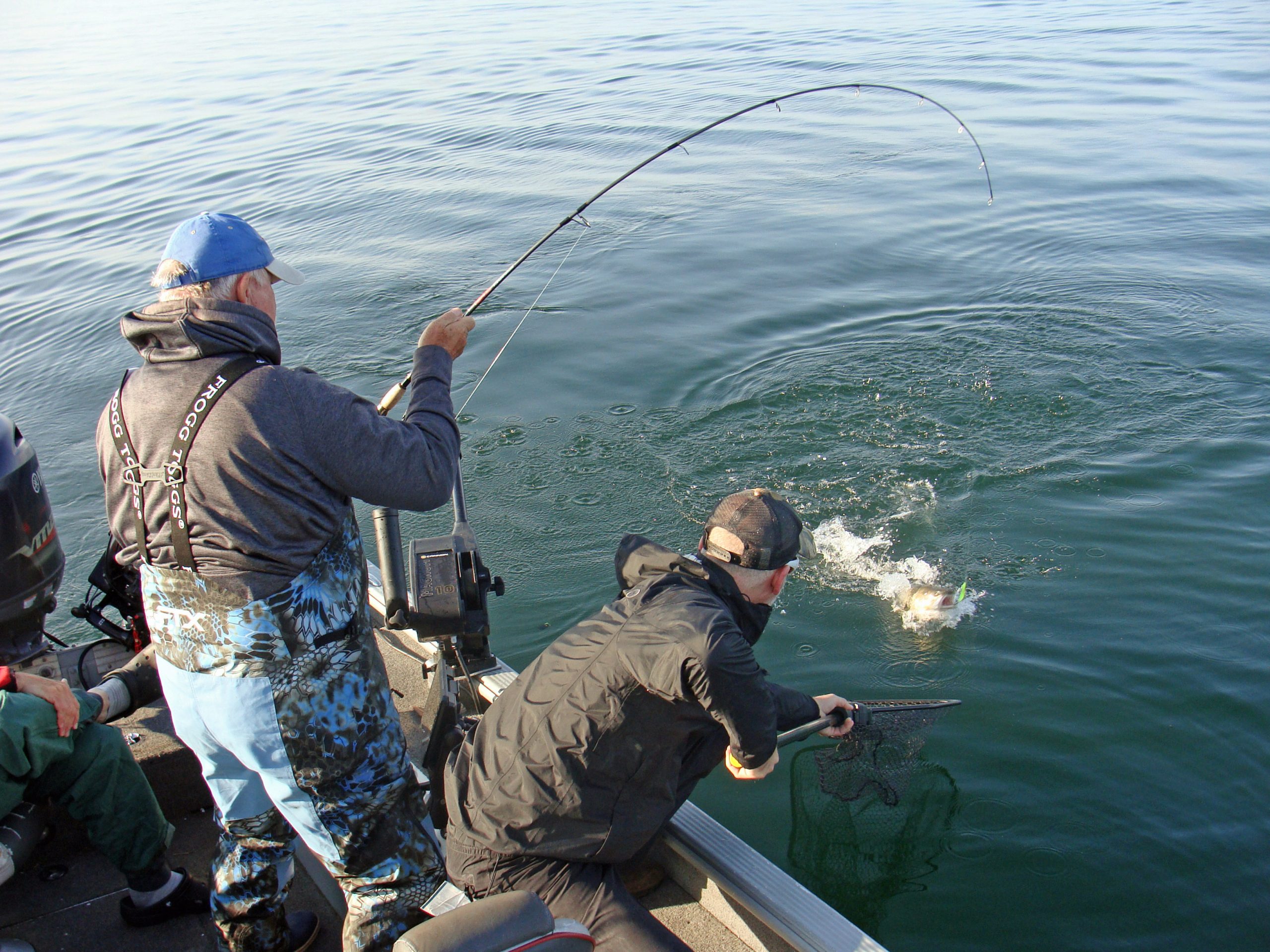
Lake Superior is the largest freshwater lake in the world, and the fishing for its resident lake trout is legendary. We easily caught more than 50 lake trout per day while we were there, and I’m sure we could have caught more if we spent less time traveling to different reefs searching for even larger trout than those we were catching. Plan your own trip for the summer of 2024—you will be glad that you did.
MWO
SHARE THIS POST
Did you enjoy this post?
You can be among the first to get the latest info on where to go, what to use and how to use it!
Tom Berg
A lifelong outdoorsman and award-winning outdoor writer and nature photographer, Tom Berg has been the Executive Director/Treasurer of the Hoosier Outdoor Writers group for the past 14 years. When he is not writing, he would rather be outside fishing, hunting or trapping than doing just about anything else.
